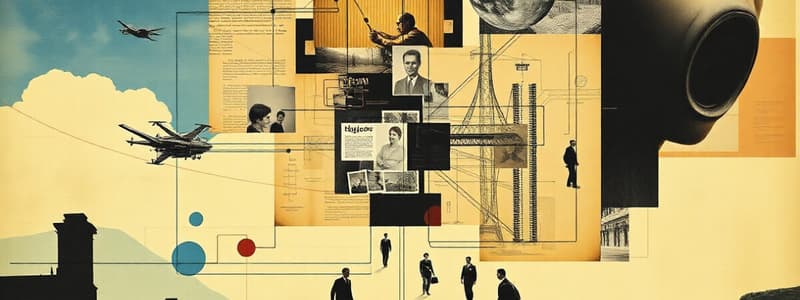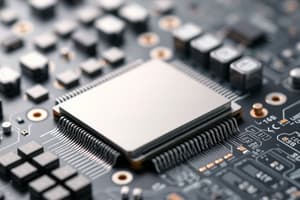Podcast
Questions and Answers
Which of the following disciplines is NOT typically involved in building an IoT ecosystem?
Which of the following disciplines is NOT typically involved in building an IoT ecosystem?
- Financial analysts (correct)
- Physicists
- Embedded system engineers
- Data scientists
IoT's primary strength comes from the limited amount of sensory data it collects.
IoT's primary strength comes from the limited amount of sensory data it collects.
False (B)
Name a key architectural decision in IoT systems beyond data analytics and networking.
Name a key architectural decision in IoT systems beyond data analytics and networking.
Security
Using the wrong __________ can cause poor communication and signal quality in an IoT system.
Using the wrong __________ can cause poor communication and signal quality in an IoT system.
Match the following roles with their primary responsibility in an IoT ecosystem:
Match the following roles with their primary responsibility in an IoT ecosystem:
Which of the given choices is NOT a main component of IoT systems?
Which of the given choices is NOT a main component of IoT systems?
Novel energy solutions like energy harvesting extend the operational life of sensors.
Novel energy solutions like energy harvesting extend the operational life of sensors.
Name two challenges in transmitting data from sensors to cloud services.
Name two challenges in transmitting data from sensors to cloud services.
__________ communication is used for short-range Personal Area Networks (PANs).
__________ communication is used for short-range Personal Area Networks (PANs).
What role do gateways and routers play in IoT data transmission?
What role do gateways and routers play in IoT data transmission?
Edge and fog computing increase the need to transfer all data to the cloud.
Edge and fog computing increase the need to transfer all data to the cloud.
Explain how advanced analytics transform sensor data into actionable insights.
Explain how advanced analytics transform sensor data into actionable insights.
__________ encryption methods can mitigate threats in IoT devices deployed in public locations.
__________ encryption methods can mitigate threats in IoT devices deployed in public locations.
Which communication technology is NOT typically used in IoT systems for data transmission?
Which communication technology is NOT typically used in IoT systems for data transmission?
Efficient routing protocols are unnecessary for IoT devices due to high memory availability.
Efficient routing protocols are unnecessary for IoT devices due to high memory availability.
Why is data security a major concern for IoT devices deployed in public locations?
Why is data security a major concern for IoT devices deployed in public locations?
Cloud architectures like SaaS, IaaS, and __________ are used to process IoT data.
Cloud architectures like SaaS, IaaS, and __________ are used to process IoT data.
Which factor is LEAST relevant when powering billions of sensors in an IoT ecosystem?
Which factor is LEAST relevant when powering billions of sensors in an IoT ecosystem?
Sub-nanometer sensors negate the need for energy-efficient designs.
Sub-nanometer sensors negate the need for energy-efficient designs.
Explain the trade-offs between using cloud computing versus edge computing in an IoT architecture that monitors a remote oil pipeline for leaks, requiring immediate shut-off in case of a major breach.
Explain the trade-offs between using cloud computing versus edge computing in an IoT architecture that monitors a remote oil pipeline for leaks, requiring immediate shut-off in case of a major breach.
Flashcards
What is an IoT ecosystem?
What is an IoT ecosystem?
Ecosystems that use sensors to convert physical phenomena into digital signals.
IoT Ecosystem Experts
IoT Ecosystem Experts
They develop sensor tech, manage edge sensors, handle networking, analyze data, build ML algos and deploy cloud solutions.
Main IoT Components
Main IoT Components
Sensing and power, data communication, Internet/routing protocols, cloud/fog computing, and security.
What is Energy Harvesting?
What is Energy Harvesting?
Signup and view all the flashcards
Sensor Communication Challenges
Sensor Communication Challenges
Signup and view all the flashcards
What is Non-IP Communication?
What is Non-IP Communication?
Signup and view all the flashcards
Key IoT Communication Technologies
Key IoT Communication Technologies
Signup and view all the flashcards
What are Gateways and Routers?
What are Gateways and Routers?
Signup and view all the flashcards
Cloud Architechtures
Cloud Architechtures
Signup and view all the flashcards
What are advanced analytics and rules engines?
What are advanced analytics and rules engines?
Signup and view all the flashcards
Why is security a major concern?
Why is security a major concern?
Signup and view all the flashcards
How to mitigate security threats?
How to mitigate security threats?
Signup and view all the flashcards
Study Notes
IoT System Architecture
- IoT ecosystems start with sensors that convert physical phenomena like movement and temperature into digital signals.
- The power of IoT is in collecting vast amounts of sensory data, which is then transmitted to the cloud.
- Building a complete IoT ecosystem needs experts from different fields.
- Physicists are needed for creating sensor tech and batteries.
- Embedded systems engineers manage sensors at the edge.
- Network engineers handle PAN, WAN, and software-defined networking.
- Data scientists analyze data and create machine learning algorithms.
- DevOps engineers deploy scalable cloud and fog solutions.
- IoT architecture needs careful design choices for cloud storage, security, networking, and data analytics.
- Choosing the wrong protocol, like PAN, can cause poor communication and signal quality.
- Decisions about Internet protocols such as MQTT, CoAP, AMQP, and fog computing are vital for managing latency and bandwidth.
- IoT systems have five main parts: sensing and power, data communication, Internet/routing protocols, cloud/fog computing, and security.
- Sensors are now smaller and cheaper.
- Powering billions of sensors needs a lot of energy.
- New energy solutions like energy harvesting allow sensors to work for many years.
- Transmitting data from sensors to cloud services like Google, Amazon, and Microsoft comes with communication challenges.
- Unique addressing is needed for billions of IoT devices.
- Low-power communication helps reduce energy use.
- Efficient routing protocols are needed with low memory needs.
- High-speed, reliable communication is a must.
- IoT devices should be mobile.
- Non-IP communication like Bluetooth, RFID, and NFC is used for short-range PANs.
- IP-based communication connects IoT devices to the Internet.
- Key communication technologies include IEEE 802.15.4, low-power Wi-Fi, 6LoWPAN, RFID, NFC, Sigfox, and LoRaWAN.
- Gateways and routers connect IoT data from sensors to the Internet, providing secure, efficient, and low-latency communication.
- Cloud architectures (SaaS, IaaS, PaaS) process IoT data.
- Edge and fog computing reduce the need to transfer all data to the cloud.
- Advanced analytics and rules engines turn sensor data into useful insights.
- An example of this is detecting anomalies or using machine learning for real-time analytics.
- Security is a big concern because IoT devices are often in public, remote, or mobile locations.
- Encryption methods like asymmetric encryption can help reduce threats.
Studying That Suits You
Use AI to generate personalized quizzes and flashcards to suit your learning preferences.




